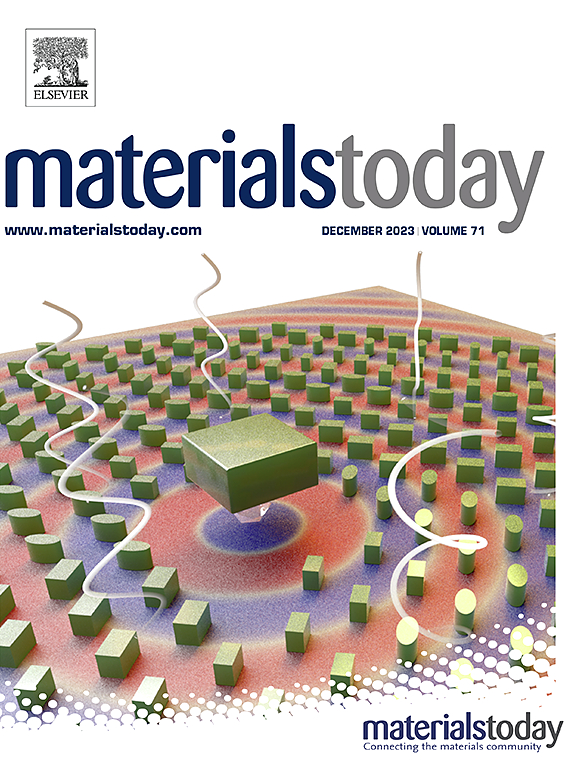熔盐中鼓泡化学蒸汽生长法连续生产端氯化MXenes
IF 21.1
1区 材料科学
Q1 MATERIALS SCIENCE, MULTIDISCIPLINARY
引用次数: 0
摘要
虽然二维过渡金属碳化物(MXenes)通常通过选择性蚀刻和化学气相沉积方法合成,但它们受到反应动力学缓慢的限制,导致其连续生产具有挑战性。本文介绍了一种鼓泡化学气相生长(BCVG)方法,该方法通过CH4和TiCl4化学气泡与钛粉在熔盐中反应连续生成cl端MXenes。在熔融反应体系中,钛粉能与TiCl4有效反应,生成高活性的[TiCl6]y -,并具有较低的TiCl键解离能。多价的[ti6ccl6]y -可以在低能垒下有效地结合CH4中的碳种在气泡表面形成[Ti6CCl18]簇,有效地促进了反应动力学。随后,基于[Ti6CCl18]簇的缩合反应,生成了cl端MXenes。合成的MXene (Ti2CClx)呈现出一种扩展结构,其基面与聚合物基体之间具有强的界面极化,具有良好的电磁波吸收性能,在2.84 mm薄层上的最小反射损耗(RLmin)值为-52.2 dB。本文章由计算机程序翻译,如有差异,请以英文原文为准。
Continuous production of Cl-terminated MXenes by bubbling chemical vapor growth in molten salt
Although 2D transition-metal carbides (MXenes) are usually synthesized by selective etching and chemical vapor deposition approaches, they are limited by the slow reaction kinetics, resulting in their continuous production challenging. Here, we demonstrate a bubbling chemical vapor growth (BCVG) method to continuously produce Cl-terminated MXenes by the reaction of CH4 and TiCl4 chemical bubbles with titanium powder in a molten salt. In the molten reaction system, titanium powder would effectively react with TiCl4 to form highly active [TiCl6]y– with low Ti![]() Cl bond dissociation energies. The multivalent [TiCl6]y– could efficiently incorporate the carbon species from CH4 to form [Ti6CCl18] clusters on the surface of bubbles in a low energy barrier, efficiently promoting the reaction kinetics. Subsequently, Cl-terminated MXenes were produced based on the following condensation reaction of [Ti6CCl18] clusters. The resultant MXene (Ti2CClx) exhibits an expanded structure with strong interfacial polarization between its basal planes and the polymer matrix, delivering a good electromagnetic wave absorption performance with a minimum reflection loss (RLmin) value of –52.2 dB at a thin thickness of 2.84 mm.
Cl bond dissociation energies. The multivalent [TiCl6]y– could efficiently incorporate the carbon species from CH4 to form [Ti6CCl18] clusters on the surface of bubbles in a low energy barrier, efficiently promoting the reaction kinetics. Subsequently, Cl-terminated MXenes were produced based on the following condensation reaction of [Ti6CCl18] clusters. The resultant MXene (Ti2CClx) exhibits an expanded structure with strong interfacial polarization between its basal planes and the polymer matrix, delivering a good electromagnetic wave absorption performance with a minimum reflection loss (RLmin) value of –52.2 dB at a thin thickness of 2.84 mm.
求助全文
通过发布文献求助,成功后即可免费获取论文全文。
去求助
来源期刊

Materials Today
工程技术-材料科学:综合
CiteScore
36.30
自引率
1.20%
发文量
237
审稿时长
23 days
期刊介绍:
Materials Today is the leading journal in the Materials Today family, focusing on the latest and most impactful work in the materials science community. With a reputation for excellence in news and reviews, the journal has now expanded its coverage to include original research and aims to be at the forefront of the field.
We welcome comprehensive articles, short communications, and review articles from established leaders in the rapidly evolving fields of materials science and related disciplines. We strive to provide authors with rigorous peer review, fast publication, and maximum exposure for their work. While we only accept the most significant manuscripts, our speedy evaluation process ensures that there are no unnecessary publication delays.
 求助内容:
求助内容: 应助结果提醒方式:
应助结果提醒方式:


